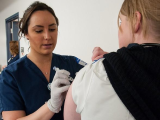Apr 18, 2011 (CIDRAP News) – Children have been getting influenza vaccinations in greater numbers and earlier in the season in recent years, but parents have not responded to efforts to extend the flu vaccination season into January and February, according to an analysis of millions of health insurance claims.
By analyzing data for the four flu seasons starting in 2006-07, researchers found that pediatric immunizations increased by 38% over that time and that immunizations began about 1 to 2 weeks earlier each season. Vaccinations increased slightly in early December each year but then declined sharply and continued to sink through the end of March, according to the early online report from Vaccine.
The study was conducted by researchers from MedImmune Inc., maker of FluMist, the nasal-spray flu vaccine, and from SDI, a company that processes health insurance reimbursement claims for outpatient care.
The study's aim was to examine trends in pediatric flu immunizations in the wake of recent changes in government recommendations. In 2004 the Centers for Disease Control and Prevention's (CDC's) Advisory Committee on Immunization Practices (ACIP) recommended flu shots for all children 6 to 23 months old, the report notes. In 2006 the committee expanded the target group to include those 24 to 59 months old, and in 2008 it added 5- to 18-year-olds.
SDI receives about 950 million health insurance reimbursement claims a year, about 60% of all claims from outpatient settings in the country, the report says. The researchers looked at all private insurance reimbursement claims for children's flu vaccinations in outpatient settings from Aug 1 through Mar 31 of each flu season.
The study did not include immunizations given through the federal Vaccines for Children (VFC) program, which covers children who are on Medicaid, have no or limited health insurance, or are American Indians or Alaska natives.
The report says the number of providers who submitted claims for flu vaccinations ranged from 29,088 to 33,341 over the four seasons. The researchers used these numbers and the known total population of physicians to generate estimates of all flu vaccine administered in US physician offices and submitted for insurance reimbursement.
The authors found that pediatric vaccinations rose 38% from the 2006-07 season through the 2009-10 season. Because of the limitations of their data, they did not attempt to estimate vaccination coverage rates.
With seasonal vaccinations starting about 1 to 2 weeks earlier each season, the start date in 2009—the year of the H1N1 pandemic—was about 4 weeks earlier than in 2006, the report says. Vaccination peaked in mid to late November in 2006 and 2007, in late October in 2008, and in late September in 2009.
Seasonal flu shots declined in late November each year but then posted a small increase in early December, the report says. Early December is when the CDC and immunization groups have promoted National Influenza Vaccination Week in recent years in an effort to boost demand for the shots.
But after early December, immunizations "dramatically declined" in the rest of December and continued to drop through the remainder of the season, the researchers found. The proportion of vaccine given in December dropped over the 4 years, while the proportions given in January and February stayed about the same. Eighty-five percent of all doses were given by the first week of January each season.
The timing of vaccinations differed somewhat by age-group: Vaccinations in those 6 to 23 months old were more spread over the season and declined less quickly in the later months than was the case for children 2 to 4, 5 to 8, and 9 to 18 years old. As a possible explanation, the authors comment that children under age 2 are more likely to have regularly scheduled doctor visits for well-child care.
In other findings, 2009 H1N1 vaccination of children began in early October of 2009—shortly after seasonal vaccination peaked—climbed to a peak in mid-December, and continued through April, the report says.
The study also showed that the use of thimerosal-free inactivated vaccine in 6- to 23-month-olds increased from 39% of all seasonal doses in 2006-07 to 58% in 2009-10, while the thimerosal-containing vaccine posted a corresponding decrease. Also, FluMist's share of all doses in 2- to 18-year-olds increased from 8% to 34% over the four seasons.
"Our results demonstrate that recent recommendations to begin vaccination as soon as vaccine is available are being adopted by office-based providers," the report says, adding that vaccine manufacturers have begun shipping doses of vaccine in August or even late July.
The reason for the low vaccination volume in the later months of the season is unknown, the researchers say. Some of the possibilities are reduced patient interest, providers' forgetfulness, and difficulty in delivering a second dose to children requiring two doses, they comment. More research is needed to shed light on the question, they conclude.
Toback SL, Herley J, Edelman L, et al. Trends in US pediatric influenza vaccination form 2006 to 2010 among children with private insurance. Vaccine 2011; early online publication [Abstract]
Dec 3, 2010, CIDRAP News story "CDC sees solid flu vaccine uptake so far"


















